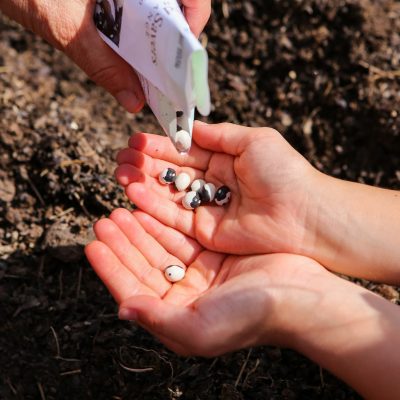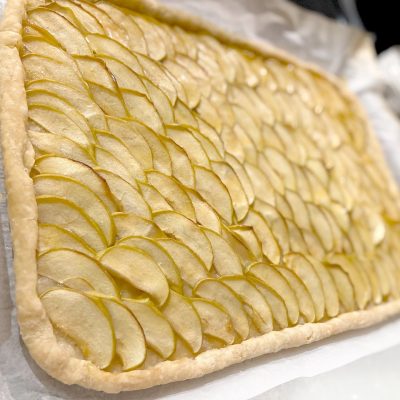Search Results
Peterson Craftsman Meats
Gift Seeds
Seeds are in, and Seward Co-op is diving into spring! Starting your garden from seed and then watching it mature from seedling to fruiting plant can be rewarding, economical and fun.
Considering Minnesota’s relatively short growing season, it can be beneficial to start seeds indoors in spring to give plants a head start before transplanting them into your garden. Each plant has its own unique growing requirements and therefore its own timeline. Refer to Seward Co-op’s Seed Guide as a resource for when to start seeds indoors and transplant outdoors.
Browsing Seward Co-op’s seed racks, surrounded by fresh-cut flowers and an abundance of fragrant citrus, can make the experience of picking out the seeds for your garden inviting—many of the potential options look so delicious and interesting!
However, before you get whisked away by the idea of it all, learn more about Seward Co-op’s seed offerings to determine which brand aligns more with your values and is best for the vision of what you hope to accomplish with your garden—High Mowing Organic, Seed Savers Exchange (a local Community Foods producer), or a combination of the two. Is your primary concern the health of your family, or is it more broad to include environmental biodiversity or healthy habitats for pollinators?
Now, the fun part—make a list of all the crops you want to grow and plot them out to create a feasible plan for your space. We recommend marking a calendar with the dates to start and transplant different crops, using the chart provided on our Seed Guide. Please note some root crops, such as carrots, beets and radishes do not tolerate transplanting. For more home gardening information and resources, please visit the University of Minnesota Extension website.
Steak Bruschetta
Recall: Wedge Co-op Burger Buns and Brat Buns
Recall: Seward Co-op Pumpkin Pie Slices and Half Pies
Apple Galette
Ingredients
2.5 cup All-purpose flour
2 Tbsp. cornstarch
1.5 lbs. apples (preferably Granny Smith apples)
½ cup sugar
½ tsp salt
2 sticks unsalted butter
1 Tbsp. ground cinnamon
1 cup ice
Optional for serving:
Apricot preserves
Apple butter
Sweetened whipped cream
Crème fraiche
Recipe Instructions
We will begin by making the dough for the galette. You will either use a food processor to mix your dough ingredients or you will use a pastry cutter. If you are using the food processor, you will want to freeze your butter in advance. If using a pastry cutter, you should store butter in the refrigerator so it is cold and firm for use in this dough recipe.
Prepare ingredients: Measure out all dry ingredients for your dough recipe.
- 2 Cups flour
- 2 Tablespoons cornstarch
- 1/5 teaspoons salt
- 1/5 teaspoons sugar
- 12 Tablespoons unsalted butter, cut into 5/8 inch cubes (basically cutting each tablespoon into four quarters)
- Cup of ice water
Cutting in the butter: Combine flour, cornstarch, salt, and sugar in food processor with three quick 1-second pulses. Scatter cubed butter over the flour mixture, pulse to cut in butter with 1-second pulses until butter pieces are the size of large pebbles or peas, approximately 6 pulses. It’s perfectly fine to have uneven sized butter clumps in the mixture- that’s preferable. The mixture itself may resemble large bread crumbs.
Adding water: Sprinkle in your cold water over the mixture 1 tablespoon at a time, incorporating into the mixture using 1-second pulses. As you add the water, 1 tablespoon at a time, you’ll notice the mixture will begin to form curds and hold together like wet sand. The dough mixture will look crumbly, but not form a cohesive ball of dough as a bread recipe might. You should be adding about 7 tablespoons of cold water in total, but you may need slightly more depending on how your flour measurements came out.
Form dough disc and chill: Empty dough mixture into a large bowl that can fit into your refrigerator and, using your clenched fist, use your knuckles/hands to firmly press the dough mixture into the base of the bowl so that if all holds together and forms a thick disc. Cover the pastry with plastic wrap and chill in refrigerator for 30-40 min (or make and chill 1-2 days in advance). Note: If using hands and pastry cutter to mix dough instead of a food processor, you may wish to pour the dough mixture onto a clean working surface to gently fraisage the dough, taking care not to overwork the dough as we want to maintain those butter clumps. Instructor will walk through fraisage method during the webinar.
Prepare apples and preheat oven: To prevent browning of apples before baking, be sure that your oven is preheated to 400 degrees Fahrenheit just before you prepare to cut up your apples. This may take 15-20 minutes depending on your individual oven. Position oven rack to middle position. Core and half apples. You may choose to peel them; this recipe leaves the apple skin on. Cut apple halves length-wise into 1/8 inch thick slices. We are aiming for nice, thin slices to ensure the apple bakes evenly. The number of apples you require depends largely on the size of the apples you’ve purchased. (3-4 medium apples or 4-5 smaller sized apples)
Roll it out: Place a 16×12 piece of parchment paper on a clean work surface and lightly flour it to all edges to prevent dough from sticking. Remove dough from refrigerator and, using a rolling pin rubbed with flour, roll it out to create a rectangle that reaches all four sides of the parchment paper and is about 1/8 on an inch thick. You will likely need to dust a bit of flour onto the top of the dough as you roll it out to prevent sticking. Grab your rimmed baking sheet with one hand, placing the long edge of the baking sheet against the edge of your counter top/work surface. With the other hand, grab the parchment paper edge and slowly slide the parchment paper with rolled out dough onto the baking sheet. It’s okay that the edges of the dough are hanging over the edges of the baking sheet- that’s what we want. Place baking sheet on a sturdy work surface and, using your fingertips, gently roll up each edge and pinch the edge to help form a small border.
Apple art-making: You can get creative with the layout of your apple slices, but for this particular demonstration we will be scalloping the slices starting in one corner, overlapping them slightly as we work to fill the galette base. Once apple slices are completely laid out, dot with butter chips that you cut from 2 tablespoons of chilled butter using a paring knife. Evenly sprinkle 1/4 cup of sugar over the apples and place in the oven on the middle rack.
Bake: Depending on your oven and the color of your baking sheet, you may bake your galette as little as 45 min or as much as a full hour. Bake until the bottom of the galette is deep golden brown and the apples have caramelized. Carefully check the bottom of the galette dough about 40 min into your bake time to get a sense of how dark the base is. If you don’t see any or very little golden brown color showing, you may wish to increase your bake time. Remove from oven and gently slide parchment paper and galette onto wire cooling rack.
Glaze, cool, and serve: While the galette is baking, combine 5 tablespoons of either the apricot preserves or the apple butter with 2.5 tablespoons of water in a medium microwave-safe bowl. Microwave the mixture on medium power until you begin to see bubbles around the edges of the mixture. This may take 45 seconds to 1 minute depending on your individual microwave. Pour heated mixture through a mesh strainer into a clean bowl and press to remove any large pieces of fruit. You may wish to set aside the strained fruit bit for another use. Brush baked galette as soon as it comes out of the oven and is placed on cooling wire rack to ensure even application of the glaze. If using the apple butter glaze, you may wish to take a small pinch of ground cinnamon and sprinkle a very small amount over the apple butter glaze. Ground cinnamon can be bold and bossy so a little goes a very long way. Galette should be allowed to cool for 10-15 min before being transferred to a cutting board and cut for serving. When serving you may wish to add a dollop of whipped cream, crème fraiche, or vanilla ice cream!
Galette can be stored on the countertop for 1-2 days. If your climate is very dry, you may wish to store in plastic freezer bags or containers. Galette slices can be reheated in a toaster oven or conventional oven at 300 degrees Fahrenheit to ensure a flakey crust. You will need to check the galette slice for readiness by touching the crust gently to sense for warmness and slight crispness while warming up a slice. It only take a minute or two.
Recipe provided by Katie Burns







